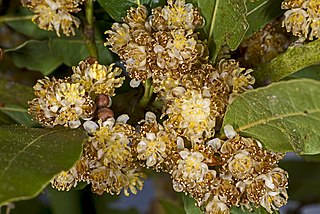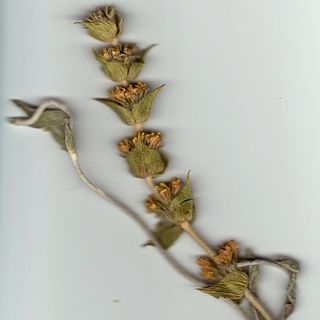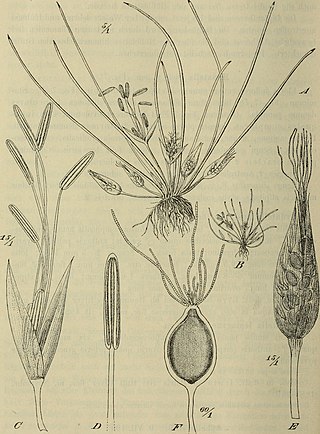
The Laurales are an order of flowering plants. They are magnoliids, related to the Magnoliales.

The order Lamiales are an order in the asterid group of dicotyledonous flowering plants. It includes about 23,810 species, 1,059 genera, and is divided into about 25 families. These families include Acanthaceae, Bignoniaceae, Byblidaceae, Calceolariaceae, Carlemanniaceae, Gesneriaceae, Lamiaceae, Lentibulariaceae, Linderniaceae, Martyniaceae, Mazaceae, Oleaceae, Orobanchaceae, Paulowniaceae, Pedaliaceae, Peltantheraceae, Phrymaceae, Plantaginaceae, Plocospermataceae, Schlegeliaceae, Scrophulariaceae, Stilbaceae, Tetrachondraceae, Thomandersiaceae, Verbenaceae.

The Lamiaceae or Labiatae are a family of flowering plants commonly known as the mint, deadnettle or sage family. Many of the plants are aromatic in all parts and include widely used culinary herbs like basil, mint, rosemary, sage, savory, marjoram, oregano, hyssop, thyme, lavender, and perilla, as well as other medicinal herbs such as catnip, salvia, bee balm, wild dagga, and oriental motherwort. Some species are shrubs, trees, or, rarely, vines. Many members of the family are widely cultivated, not only for their aromatic qualities, but also their ease of cultivation, since they are readily propagated by stem cuttings. Besides those grown for their edible leaves, some are grown for decorative foliage. Others are grown for seed, such as Salvia hispanica (chia), or for their edible tubers, such as Plectranthus edulis, Plectranthus esculentus, Plectranthus rotundifolius, and Stachys affinis. Many are also grown ornamentally, notably coleus, Plectranthus, and many Salvia species and hybrids.

The order Pinales in the division Pinophyta, class Pinopsida, comprises all the extant conifers. The distinguishing characteristic is the reproductive structure known as a cone produced by all Pinales. All of the extant conifers, such as Araucaria, cedar, celery-pine, cypress, fir, juniper, kauri, larch, pine, redwood, spruce, and yew, are included here. Some fossil conifers, however, belong to other distinct orders within the division Pinophyta.

Gnetophyta is a division of plants, grouped within the gymnosperms, that consists of some 70 species across the three relict genera: Gnetum, Welwitschia, and Ephedra. Fossilized pollen attributed to a close relative of Ephedra has been dated as far back as the Early Cretaceous. Though diverse in the Early Cretaceous, only three families, each containing a single genus, are still alive today. The primary difference between gnetophytes and other gymnosperms is the presence of vessel elements, a system of small tubes (xylem) that transport water within the plant, similar to those found in flowering plants. Because of this, gnetophytes were once thought to be the closest gymnosperm relatives to flowering plants, but more recent molecular studies have brought this hypothesis into question, with many recent phylogenies finding them to be nested within the conifers.

Amaranthaceae is a family of flowering plants commonly known as the amaranth family, in reference to its type genus Amaranthus. It includes the former goosefoot family Chenopodiaceae and contains about 165 genera and 2,040 species, making it the most species-rich lineage within its parent order, Caryophyllales.

Hamamelidaceae, commonly referred to as the witch-hazel family, is a family of flowering plants in the order Saxifragales. The clade consists of shrubs and small trees positioned within the woody clade of the core Saxifragales. An earlier system, the Cronquist system, recognized Hamamelidaceae in the Hamamelidales order.

The order Cyatheales, which includes most tree ferns, is a taxonomic order of the fern class, Polypodiopsida. No clear morphological features characterize all of the Cyatheales, but DNA sequence data indicate the order is monophyletic. Some species in the Cyatheales have tree-like growth forms from a vertical rhizome, others have shorter or horizontal expanding rhizomes.

Stachys is a genus of plants, one of the largest in the mint family Lamiaceae. Estimates of the number of species vary from about 300, to about 450. Stachys is in the subfamily Lamioideae and its type species is Stachys sylvatica. The precise extent of the genus and its relationship to other genera in the subfamily are poorly known.

Asphodelaceae is a family of flowering plants in the order Asparagales. Such a family has been recognized by most taxonomists, but the circumscription has varied widely. In its current circumscription in the APG IV system, it includes about 40 genera and 900 known species. The type genus is Asphodelus.

Phrymaceae, also known as the lopseed family, is a small family of flowering plants in the order Lamiales. It has a nearly cosmopolitan distribution, but is concentrated in two centers of diversity, one in Australia, the other in western North America. Members of this family occur in diverse habitats, including deserts, river banks and mountains.

Altingiaceae is a small family of flowering plants in the order Saxifragales, consisting of wind-pollinated trees that produce hard, woody fruits containing numerous seeds. The fruits have been studied in considerable detail. They naturally occur in Central America, Mexico, eastern North America, the eastern Mediterranean, China, and tropical Asia. They are often cultivated as ornamentals and many produce valuable wood.

Diapensiaceae is a small family of flowering plants, which includes 15 species in 6 genera. The genera include Berneuxia Decne., Diapensia L., Galax Sims, Pyxidanthera Michx., Shortia Torr. & A.Gray, and Schizocodon Siebold & Zucc.. Members of this family have little economic importance; however, some members are cultivated by florists.

Sideritis, also known as ironwort, mountain tea, and shepherd's tea, is a genus of flowering plants known for their use as herbal medicine, commonly as a herbal tea. They are abundant in Mediterranean regions, the Balkans, the Iberian Peninsula and Macaronesia, but can also be found in Central Europe and temperate Asia.

Hydatellaceae are a family of small, aquatic flowering plants. The family consists of tiny, relatively simple plants occurring in Australasia and India. It was formerly considered to be related to the grasses and sedges, but has been reassigned to the order Nymphaeales as a result of DNA and morphological analyses showing that it represents one of the earliest groups to split off in flowering-plant phylogeny, rather than having a close relationship to monocots, which it bears a superficial resemblance to due to convergent evolution. The family includes only the genus Trithuria, which has at least 13 species, although species diversity in the family has probably been substantially underestimated.

Clinopodium is a genus of flowering plants in the family Lamiaceae. It is in the tribe Mentheae of the subfamily Nepetoideae, but little else can be said with certainty about its phylogenetic position.

Hyptis is a genus of flowering plant in the family Lamiaceae. These plants, known commonly as bushmints, are widespread in tropical North and South America, as well as parts of West Africa. There are 150 species, which may be annual or perennial herb to shrub. Recently, several genera were segregated from Hyptis.

Prostanthera phylicifolia, commonly known as spiked mint-bush, is a species of plant in the family Lamiaceae. It is an erect shrub with four-ridged branches, narrow egg-shaped to oval leaves and white or pale lilac-coloured flowers with purple and yellow spots.

The Anacampserotaceae are a family of plants proposed in the February 2010 issue of the journal Taxon. The family was described by Urs Eggli and Reto Nyffeler in their analysis of the polyphyly in the suborder Portulacineae. The new family and its circumscription was based on molecular and morphological data. The three recognized genera - Anacampseros, Grahamia, and Talinopsis - were formerly placed in the Portulacaceae and comprise a total of 36 known species. This family was accepted in the Angiosperm Phylogeny Group's 2009 publication of the APG III system.

Sideritis macrostachyos is a species of flowering plant in the family Lamiaceae, native to north and north-eastern Tenerife in the Canary Islands.



















